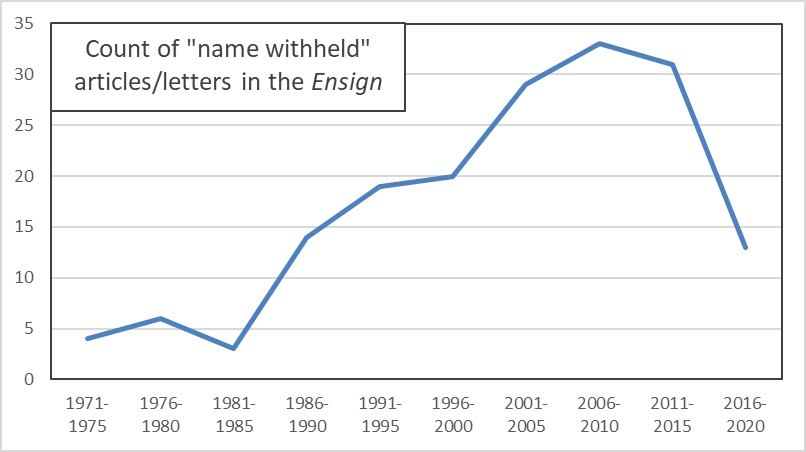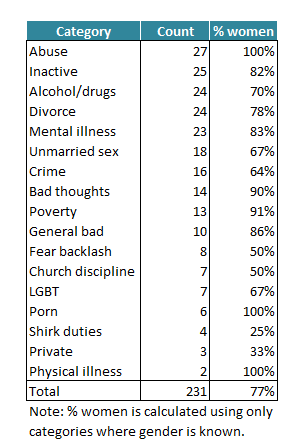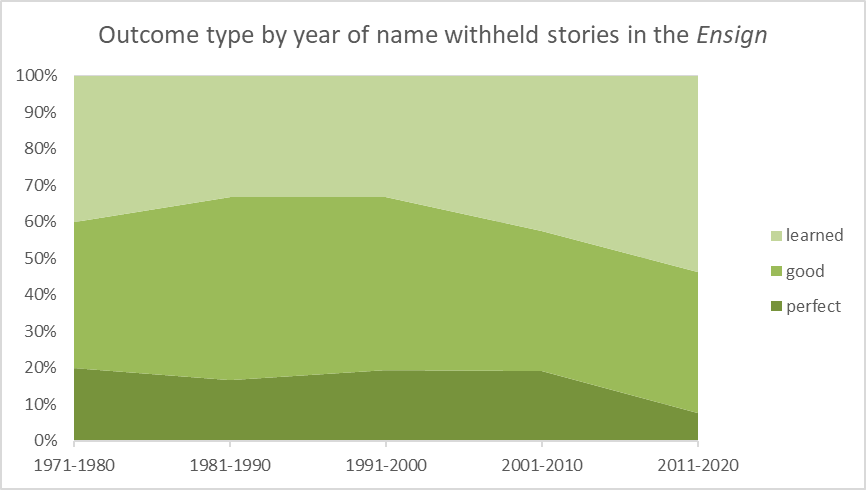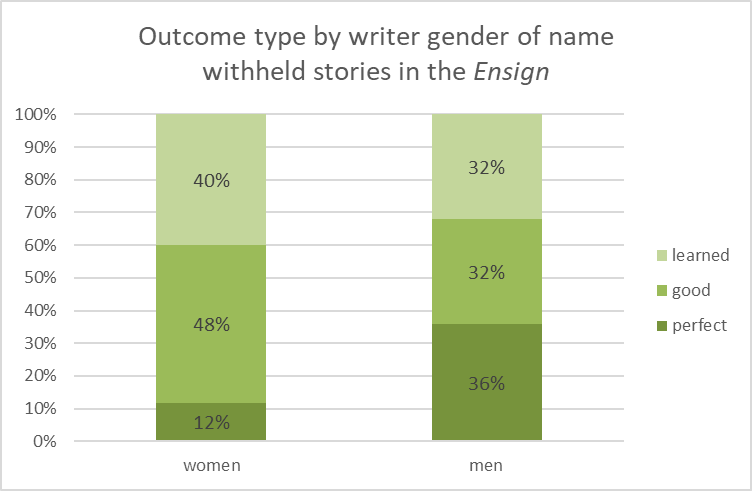A few years ago while reading the Ensign, I got to wondering about the reasons an article writer’s name is withheld. For an individual article, it’s typically pretty easy to guess, but I was wondering about larger trends. Even just cataloging the list of reasons seemed possibly interesting, because it’s a list of things that are considered shameful, but not too shameful. For example, a relatively large number of name withheld articles talk about divorce, but none that I’ve ever read talk about, say, bestiality. The articles provide a kind of list of troubling issues that are on writers’ (and editors’ and perhaps GAs’) minds. Also, while I was at it, I thought it would be fun to look at any trends across time and gender differences and a couple of other things.
I initially planned to look at all magazines on the Church website since 1971, but looking at the Ensign alone turned out to be fairly time-consuming, so I didn’t go any further. Maybe I’ll go back and look at the others another time. I found 172 articles and letters to the editor, using the search “‘name withheld’ site:churchofjesuschrist.org/study/ensign”. (To be precise, a few weren’t labeled exactly “name withheld.” I manually checked all the letters to the editor from the 1970s, after I found their authorship was occasionally noted as “A regular reader” or something similar.)
For each of the 172 documents, I noted the following:
- Publication year
- Gender of the writer (I was able to figure this out for 121 of the 172, or 70%)
- Is the name withheld because of something about the writer or something about another person?
- Is the person the actor (e.g., used porn) or the victim (e.g., was abused) in the situation?
- One or more reasons for the name to be withheld. (The max for any one document was four. Most documents had one. Three documents had zero, as I couldn’t figure out any reason at all.) I grouped these into 17 different categories, which I’ll list below with results.
- The story end type. I classified these into three different categories: perfect (where people end up married in the temple or going on missions), good (where things end up better than they started), and learned (where things don’t get better, but the writer learns to better accept them). I also assigned some documents a not applicable here when there was no story arc. This was the case for a fair number of the letters to the editor, where writers with name withheld often say no more than “I suffer from the same problem as the person in such-and-such an article.”
- How much the need to forgive the wrongdoer is discussed. I rated this as high, low (little discussion, or just reference to need to overcome bitterness and anger), or none.
I also tried noting down some other things, like the approximate age of the writer (typically difficult to figure out) or the location (rarely mentioned), but I wasn’t able to get enough useful data for them.
This graph shows the total number of documents in five-year periods across the history of the Ensign. Note that there’s no adjustment for possible differences in length of the magazine at different points in time.

Even with my extra combing through the 1970s issues, the prevalence of “name withheld” documents really didn’t take off until the latter half of the 1980s. It’s also interesting that it has dropped so dramatically in the latter part of the 2010s. I wonder if this is a change Russell M. Nelson has made, because even the 13 in the 2016-2020 period can be broken down into six in 2016 and seven total in the four following years.
I mentioned above that I was able to work out the gender for 121 of the documents. For 94 of them (78%), the writer was a woman. This seems really striking to me, considering how many Mormon spaces are dominated by men. It may just be a reflection of women writing more of the personal experience articles in the Ensign. I also wonder, though, if it’s related to women often taking on the burden of relationship management. A man uses porn? His wife writes about it. Teens are having sex? Their moms write about it. A couple gets divorced? The woman writes about it.
For 161 of the 172 documents, I was able to attribute the name withheld reason to either the writer or to another person in the story. Of the 161, 90 (56%) were about the writer. For women writers, the reason was more often about someone else (47 of 87, or 54%), whereas for men writers, the reason was more often about themselves (16 of 25, or 64%). Women writing more about others is consistent with what I guessed above about the gender breakdown of the writers. (Note that the women’s and men’s totals don’t sum to 161 because of the documents for which I couldn’t determine the writer’s gender.)
I was able to assign whether the name withheld reason related to a person being an actor or a victim for 161 of the 172 documents. (For most of the 11 others, the person was both.) Writers more often wrote about the person as an actor (104 of 161, or 65%) than as a victim (57 of 161, or 35%). Both women and men wrote more often about actors than victims, but women wrote more often about victims (34 of 89, or 38%) than med did (4 of 26, or 15%). (Note that the women’s and men’s totals don’t sum to 161 because of the documents for which I couldn’t determine the writer’s gender.)
This next table shows how often the 231 reason categories were assigned across the 172 documents. For each category, I’ve also shown how often the category is used that the writer is a woman (counting only documents where the writer’s gender is identifiable). I think it’s interesting to see that women do all the writing about abuse and porn, while men are overrepresented in writing about, for example, crime (often only implied, as someone is in jail or prison).

I want to clarify a few of the categories. Divorce includes other relationship issues, although the vast majority of the time, it’s just divorce. Mental illness includes depression and suicidality. Unmarried sex, as you can probably guess, is typically not written about as that, but rather as unmarried pregnancy. Bad thoughts includes all kinds of things like being judgmental and taking offense. General bad is a category I made up as a catch-all for when writers are overly vague about (typically) their teen children’s naughtiness. Private is for things like a couple who is hoping to adopt and might not want the whole world to know.
I looked at trends across time for each of the categories, but unfortunately, the data are already pretty thin, and there’s not much to say about it. Even the most-used category–abuse–is only showing up about every other year across the Ensign‘s 50-year history. With that caveat, divorce shows up pretty consistently across the years, and on the other hand, as you might expect, porn and LGBT don’t show up until the 2000s.
This next graph shows story outcome type across time. Here there are just the three categories, so the thin data is less of an issue. I thought this was maybe interesting that there seems to be a shift in the most recent decade to stories where the writer learns to accept a bad thing, and a move away from the “happily ever after” endings.

This next graph shows the breakdown by writer gender (including only the documents where gender can be determined). It looks like men were more prone to write stories with a perfect ending, and women more often wrote about learning to accept difficult things.

The last pattern I found is that women writers were far more likely to write about needing to forgive harms done to them. Of 94 documents written by women, I classified 9 (10%) as high in forgiveness focus, and 8 (9%) as low, with the rest being classified none. This might not sound like a lot, but for men, none of the 27 documents rated high, and only 2 (7%) rated low. This is a disappointing but not a surprising finding, considering how often anecdotally I’ve heard women report that when they go to their leaders about having been abused or raped, the leaders’ first priority seems to be getting them to forgive their abusers and attackers. The same admonition doesn’t seem to be directed to men.
One last note is about the content of these documents. The issue in the previous paragraph notwithstanding, I was impressed at how many articles had encouraging ending like stories of parents realizing that they needed to just love their wayward children where they were, and stop trying to dragoon them back into the Church. On the other hand, if you want to read the absolute worst of these documents, look no further than this doozy from 1981. The writer struggled in her relationship with her non-Mormon husband for a long time, but everything was solved once she started following the advice in Fascinating Womanhood (although the book isn’t explicitly named, it’s clearly the inspiration).
Fascinating. You always come up with the most interesting things to analyze.
Thanks, Michelle!
Michelle wrote almost word for word what I had in mind. It’s fascinating, both for what you’ve encountered — but also that you even thought to query the issue, and then found ways to measure it.
Thanks, Ardis! I’m glad you enjoyed it!
It is clear that there were church leaders who believed that the names of all female contributors should be withheld for various reasons.
Speaking of withholding, why are your excellent semiannual conference predictions being withheld?
Sorry, Ivy. I fell down on the job with predictions this time.